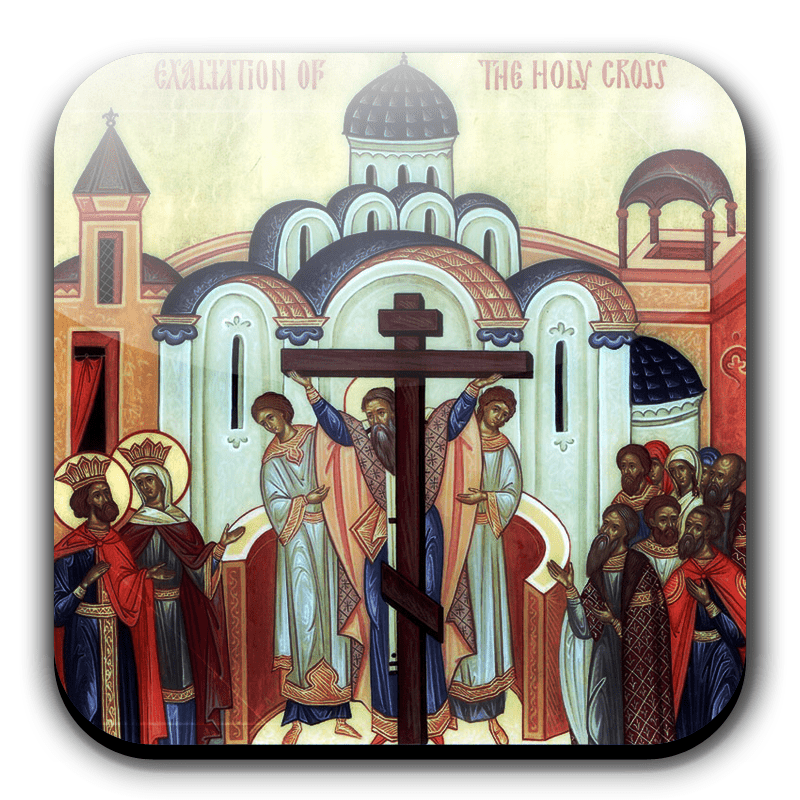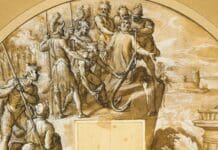On the Feast of the Exaltation of the Cross (or Triumph of the Cross) we honor the Holy Cross by which Christ redeemed the world. The public veneration of the Cross of Christ originated in the fourth century, according to early accounts. The miraculous discovery of the True Cross on September 14, 326, by Saint Helen, mother of Constantine, while she was on a pilgrimage to Jerusalem, is the origin of the tradition of celebrating the Feast of the Exaltation of the Cross on this date. Constantine later built the Church of the Holy Sepulchre on the site of her discovery of the cross. On this same pilgrimage she ordered two other churches built: one in Bethlehem near the Grotto of the Nativity, the other on the Mount of the Ascension, near Jerusalem.
In the Western Church the feast came into prominence in the seventh century — after 629, when the Byzantine emperor Heraclitus restored the Holy Cross to Jerusalem, after defeating the Persians who had stolen it.
It remained in Christian hands until the Battle of Hattin in 1187, when the Moslem leader Saladin captured the relic. Saladin after the Battle of Hattin and the capture of Jerusalem, would ride his horse through the streets with the Holy Relic dragging behind his mount’s tail.
Christians “exalt” (raise on high) the Cross of Christ as the instrument of our salvation. Adoration of the Cross is, thus, adoration of Jesus Christ, the God Man, who suffered and died on this Roman instrument of torture for our redemption from sin and death. The cross represents the One Sacrifice by which Jesus, obedient even unto death, accomplished our salvation. The cross is a symbolic summary of the Passion, Crucifixion and Resurrection of Christ — all in one image.
The Cross — because of what it represents — is the most potent and universal symbol of the Christian faith. It has inspired both liturgical and private devotions: for example, the Sign of the Cross, which is an invocation of the Holy Trinity; the “little” Sign of the Cross on head, lips and heart at the reading of the Gospel; praying the Stations (or Way) of the Cross; and the Veneration of the Cross by the faithful on Good Friday by kissing the feet of the image of Our Savior crucified.
Placing a crucifix (the cross with an image of Christ’s body upon it) in churches and homes, in classrooms of Catholic schools and in other Catholic institutions, or wearing this image on our persons, is a constant reminder — and witness — of Christ’s ultimate triumph, His victory over sin and death through His suffering and dying on the Cross.


















Prayer Before a Crucifix +++ Look down upon me, good and gentle Jesus while before Your face I humbly kneel and, with burning soul, pray and beseech You to fix deep in my heart lively sentiments of faith, hope, and charity; true contrition for my sins, and a firm purpose of amendment. While I contemplate, with great love and tender pity, Your five most precious wounds, pondering over them within me and calling to mind the words which David, Your prophet, said of You, my Jesus: “They have pierced My hands and My feet, they have numbered all My bones.” Amen.
All holy men and women, martyrs, saints, angels, pray for us. Let Truth be honoured and Light be cast into every shadow. Holy Family of Nazareth, restore matrimony and family life. Transform all of mankind’s iniquity into integrity.
Ecce Crucem Domini!
Fugite partes adversae!
Vicit Leo de tribu Juda,
Radix David! Alleluia!
Saint Anthony of Padua, pray for us. For Italy.
Saint Teresa of Avila, pray for us. For Rome.
Blood of Christ Crucified, cleanse the Vatican.
Amen.